Mazda MX-30 GT Sport Tech
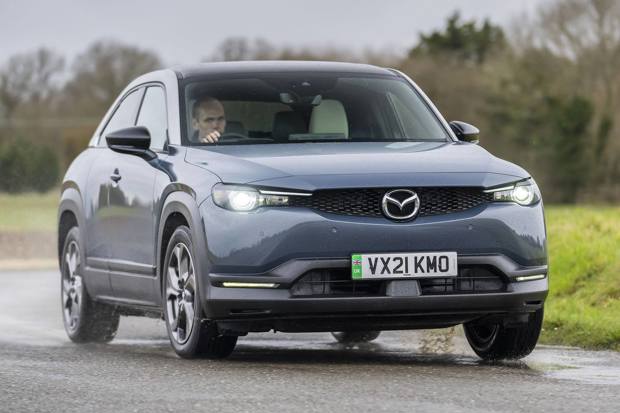

- She's electric: Mazda MX-30 joins the HJ fleet
- There's an app for that...
- How fast? Which connector? How much? Getting to grips with MX-30 charging basics
- Just how safe is the Mazda MX-30?
- Details that make the Mazda MX-30 stand out
- Does the MX-30 benefit from an improving charging network?
- Out and about charging - what has been my experience?
- No complaints from readers about the Mazda MX-30 - but what about other electric cars?
She's electric: Mazda MX-30 joins the HJ fleet
We're going to be running Mazda's curious electric car for 12 months. Will we get fed up of its 124-mile range in that time?

Date: 30 March 2021 | Current mileage: 385 | Claimed range: 124 miles | Actual range: 102 miles
Mazda is a bit of an oddity. When other car manufacturers were launching hot hatches in the late 80s, it sensed the time was right for a two-seater sports car. More recently, it snubbed the downsizing trend and fitted its petrol models with large (not particularly powerful) petrol engines. The brand's marketing bods dubbed this 'rightsizing' – simply, fitting the right sized engine to the car and revelling in realistic real world fuel economy figures and impressive reliability.
So it's with bated breath that we've been waiting to see what Mazda will do with electric power. The MX-30 is the Japanese brand's first electric vehicle (it hasn't even done a 'proper' hybrid before) and it looks, well, surprisingly normal. And by that we mean normal by Mazda's standards. The brand has one of the most attractive line-ups in the market today, in our eyes, and the MX-30 is no exception.
A few curiosities aside (it has rear-hinged doors – a nod to the RX-8 sports car), the MX-30 simply looks like a very stylish small crossover. Only the lack of exhaust tailpipes, a small 'e-Skyactiv' badge on the tailgate and the green strip on the number plates really give it away as an EV.
Of course, being a Mazda, it's when you look at the technical bits that things get a bit peculiar. For now, there's only one battery available: a small 35.5kWh power pack. That results in a fairly meagre range of 124 miles. Or about 100 in the real world.

That's where rightsizing comes in again, says Mazda. Most electric car buyers don't actually want to travel hundreds of miles between charges. They have another car for that, so lugging around a massive battery that they're not going to make the most of is massively inefficient.
We're going to be putting this to the test. A Mazda MX-30 is joining the HonestJohn.co.uk fleet for the next 12 months and we'll be looking to use it just like we would any petrol or diesel model – the weekly shop, commuting, going away on holiday; you name it, we'll be using the MX-30 for it.
Our test car is a top-spec GT Sport Tech model. We'll cover in more detail what that means in a future update, but standard kit includes a fancy 12-speaker Bose sound system, a 360-degree camera and a heated steering wheel. We've gone for Polymetal Grey with the stylish (and expensive) contrasting roof.
This lists at £34,345, meaning – after changes announced on the day we collected the car – it still qualifies for the Government's plug-in car grant, bringing the price you'd pay down to £31,845 including options. In finance terms, you'll be looking at around £415/month for an MX-30 in this spec with a £4000 deposit. We'll be providing updates every two weeks so keep an eye on the Our Cars page for all the latest on life with the MX-30.
There's an app for that...
As the line between tech and cars becomes ever more blurred, Dan connects the Mazda MX-30 to its app. Question is: Is it useful or just a case of technology for technology’s sake?
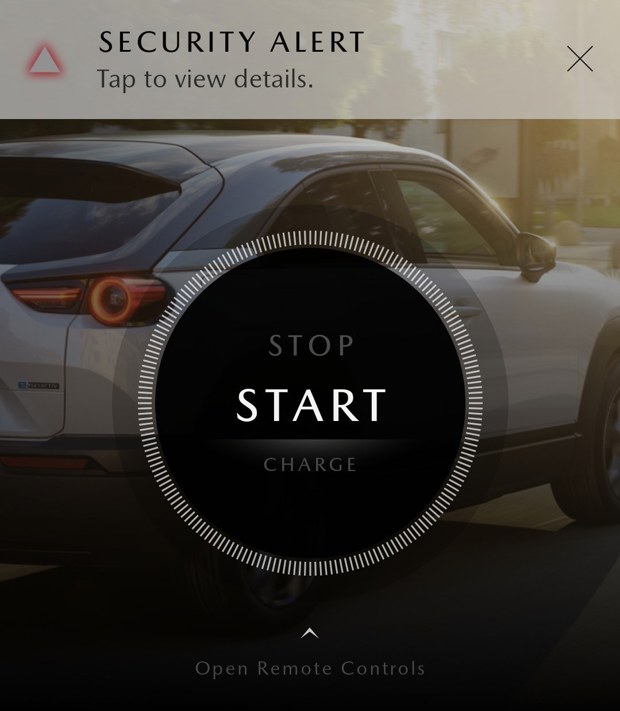
Date: 3 May 2021 | Current mileage: 1276 | Claimed range: 124 miles | Actual range: 115 miles
We’ve become ever more reliant on our mobiles. They can do anything, it seems, from streaming music hosted on a server thousands of miles away, to switching on and off lights in your house. It’s even said that there’s a little-known function that will let you speak to a human being - though this is yet to be confirmed.
I joke. Kinda.
In all seriousness, most of what you can do with your phone these days is truly astonishing - the stuff of science fiction just a few years back. But it can all be a little overwhelming and all of us have apps on our phones that we’ve used just once or twice and forgotten about. If I browse at mine, I have various apps for theme parks, loyalty schemes, games and apps for other pieces of tech that I don’t use any more.
So do I need one for my car?
Up until fairly recently, the connectivity with your car has been limited to - assuming your car is new enough - to Bluetooth for playing music and making calls, with the introduction of Apple CarPlay and Android Auto more recently, which synchs some more sophisticated systems like maps for Sat Nav.
But, things are changing and a much deeper integration between the tech in your pocket and cars is starting to become more commonplace - and as electric cars hit the roads in ever larger numbers - having an app is becoming part and parcel of the car ownership experience.
The ‘MyMazda’ app available for the Mazda MX-30 is one such system and is designed to control a series of the car’s systems from the comfort of your armchair and provide alerts at critical times - i.e if the car is unlocked, charging or has finished charging.
As with all apps, the first step is to download it - in my case with a Samsung S9, that means from Google Play.
 |
From there, the app guides you through the process of connecting your car with some clever back-end technology that has more than a whiff od black magic about it. You’ll need to set aside around 20 minutes to get through this and you’ll need all the vehicle's key info to hand - including its VIN. But, it’s all very straightforward and the in-built software does a great job of taking you through the process, which is perfect for any technophobes. For the latter stages of the connecting up, you’ll need to be in the car itself for the final hook-up.
That then means you can control a whole range of features and check key features within the car. Among the highlights are being able to control the heating. With no engine required, you can define the cabin temperature, turn on/off windscreen ventilation and adjust the rear screen heating before getting in the car. You can also pre-warm or pre-cool the car while it is plugged in, to reduce demand on the battery once driving. Aso via the ‘MyMazda’ app, you can control door locks, find the vehicle, and access information such as tyre pressures.

Although packed with the features above, I’ve found that there’s just a handful of alerts and functions that I use - but I use them a lot. As you can imagine, most of them are around charging. The app sends notifications when the car is charging and has fully charged, which is really useful. If you’re charging overnight (more on that in a following update), waking up to a notification to let you know that it has fully charged is reassuring - especially if you have an early morning trip. You can also see how full the battery is and what the range is - perfect for those moments when you’re not sure whether the car is fully charged or not and you don’t want to go outside to check (could be late night, cold, wet etc…).
How fast? Which connector? How much? Getting to grips with MX-30 charging basics
Owning and driving an electric car means getting used to a whole new vocabulary - but what do I need to know about the Mazda MX-30 in order to get the best from it?
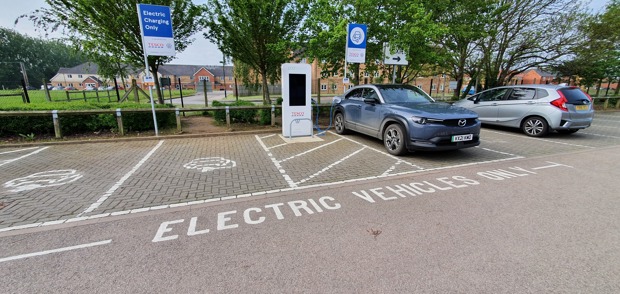
Date: 16 June 2021
I’ve driven electric cars of one sort or another for more than a decade and they’ve come a hell of a way - and so has the infrastructure.
But these drives have tended to be short term, up to a week and I’ve never had to rely on an electric car until now.
And to get the most out of th MX-30, that means getting to grips with a new lexicon of terms and having a firm grasp of how it fits into day-to-day life. Below, I set out to answer the questions that I had before taking on this car - and some you may have too.
Do you need a wall charger in order to charge a Mazda MX-30?
As long as you have a safe outside charger, you can charge your Mazda MX-30. It comes with two types of connectors - a connector that uses a three-pin plus (just don’t use a standard extension leads, as it can melt) and a Mennekes Type 2 connector - this is the one you will need if you’re out and about, though many points also have a built-in cable. The ultra-fast chargers use a CCS connector. You do not get a cable for this, as they are built-in to the charger points. To access the CCS point in the car, you need to remove both of the plastic socket points (normally just the top one is removed).
What is the range of the Mazda MX-30?
On a full charger the range of the Mazda MX-30 is about 125 miles. Although one of the smaller ranges on paper, In everyday driving, it seems to be pretty accurate - some electric cars promise decent range, but fail to deliver in the real world.
Can you rapid charge a Mazda MX-30?
Yes, you can use a rapid charger, which on paper will charge from 20-80% in about 30 minutes.

What is the charging time for a Mazda MX-30: How long does it take to charge?
This is your classic How long is a piece of string? question and the answer is - it depends. Below is a table that shows the estimated time to charge the Mazda MX-5 from completely empty to fully charged. Fast chargers typically operate a little differently outside of the 20-80% range and can slow outside of this range, so the figure is broken out separately.
This gives a fascinating look into how many miles you can expect from each of the types of charger. The most basic wall socket will give eight miles for every hour it’s plugged in - so you can see it needs to be plugged in for a substantial amount of time in order to fully charge. Conversely one of the fast chargers will have you back on your way in well under an hour - these are the chargers to look for to make longer trips (slightly) more bearable.
If you’re new to electric cars, it may be something of a surprise that there are so many different types of chargers and charging speeds. Most people are aware of slower home chargers and faster chargers on-the-go - but there’s quite a bit of variation in-between and not all fast chargers are equal. Fast chargers are now springing up in decent numbers at supermarkets and these are great for a charge-up in the dead time that you’re doing your shopping. Although there are a few super-fast chargers around, most tend to be in the 2-22kw/h range, which means you’ll add about 22 miles onto the MX-30’s range if your shop takes about an hour. This is also the range of many home chargers - meaning you can fully recharge at home in around six hours - ideal if your journeys tend to be shorter, but more frequent.
|
Three-pin wall plug |
At home |
16h |
8m/h |
|
3kw |
Wallbox/work |
10 |
12m/h |
|
7kw/h |
Home/supermarkers |
6h |
22m/h |
|
22kw/h |
Work/supermarkekets/public locations |
6h |
22m/h |
|
50kw/h |
Public locations |
40min |
61m/h |
|
Charger type |
Where you’ll find it |
How long it takes to charge |
Range per hour of charge. |
How much does it cost to charge a Mazda MX-30?
My electricity tariff at home is 17p oer kw/h - which means that a full charge is around £5.50 and every mile costs just over 5p. Costs can vary when out and about from free (which is always very welcome), to around 30p / kw/h. The Mazda MX-30 has a battery capacity of 35.5 kw/h. So - assuming a full charge - that would cost about £10. Though in relaity, these chargers tend to be used for top-ups with the bulk of the charging done at home/work on lower rates.
Just how safe is the Mazda MX-30?
Buyers often have concerns that electric cars won't be as safe as conventionally-powered ones, but is that the case?
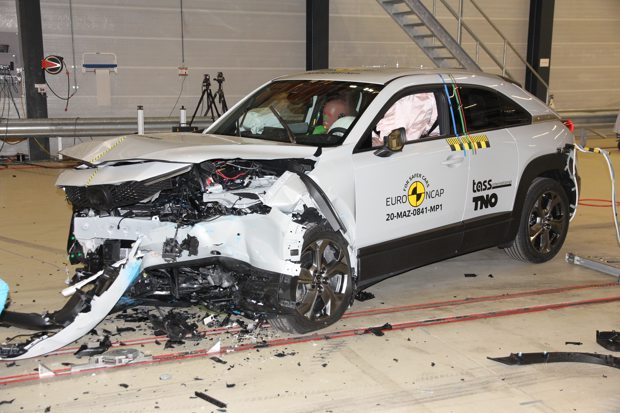
Date: 12 July 2021
One of the biggest concerns that people have when buying an electric car is safety. We hear it all the time here at HonestJohn.co.uk - if I have an accident, will I be safer or less safe in a battery car? In addition to that, there’s plenty of urban myths that go around on this issue and plenty of mis-information.
But we’re now getting to the point where electric cars are now being tested by Euro NCAP and there’s some hard independent evidence to back-up the legitimate claims made by car manufacturers.
And, on the basis of recent Euro NCAP results, there’s a lot to be encouraged by. The MX-30 turned in an impressive performance when it was crash tested by Euro NCAP, registering a five-star rating under the 2020 system.
The results showed that it has a 91% score for adult occupant protection, 87% for child occupant protection, 68% for vulnerable road user protection and 73% for its safety assist.
It was the vulnerable road user protection that concerned Euro NCAP the most, with the organisation commenting: “Mazda joins the growing list of debutant EVs with its new electric MX-30. Naturally, the CX-30 based MX-30 is heavier than its combustion-engined sister, but still delivers an impressive 91 percent for adult occupant protection, thanks to its compatible front-end structure and new far-side restraints. However, the MX-30 disappoints on its vulnerable road users’ collision avoidance capabilities, showing mediocre test performance and lacking more advanced functionalities, such as turn-across-path intervention.”
Although a five-star rating is reassuring, it comes as little surprise, as the Mazda MX-30 is packed with impressive safety features under the label of Mazda i-Activesense, which is a blend of passive safety features (i.e body strength) and active ones (i.e on-board safety systems).
The core strength of the MX-30’s body is reflected in that Euro NCAP score - and is especially impressive when you consider that there isn’t a centre pillar as you get with conventional cars. The rigid bodyshell absorbs impact energy well - as evidenced by the crash test - and the method of construction puts it on a par with cars with pillars in side impact tests.
Specifically on battery concerns in a collision, the Mazda MX-30 has a system that shuts down power as soon a crash is detected. The battery packs are also encased in high-strength material and surrounded by a rigid frame to ensure they remain intact and there are no injuries from high voltage power.
On board safety systems are headed-up by a Smart Brake Support System, that intervenes if it looks like a crash is looking likely - including junctions, Emergency Lane Keeping, which helps to keep the car within white lines, should you stray and Blind Spot Assist that alerts you to a potential accident when changing lanes. And of, course, there’s the usual suite of airbags and internal protection too.
One neat feature that’s fitted to all Mazda MX-30s is a head-up display, which is projected in colour onto the windscreen and shows all relevant driving information directly in the driver's line of sight to minimise distraction from the road ahead. This is particularly useful for taking in information like sat nav directions without taking your eyes off the road.
But what about those other electric cars, I hear you say? Well, EVs are starting to establish themselves as being just as safe as their conventionally-powered counterparts. Recent years have seen five-star crash test ratings for the Ford Mustang Mach-E, Volvo XC40 Recharge and Hyundai Ioniq 5. With more electric cars hitting the market and further crash tests being conducted, you can expect this to grow quickly throughout the coming years.
Details that make the Mazda MX-30 stand out
Style icon or style over substance? How does the MX-30 stand up?
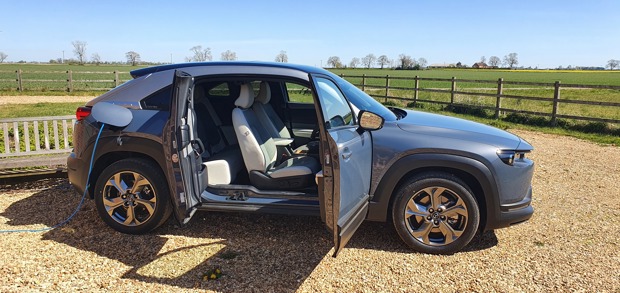
Date: 10 August 2021
Electric cars have picked up a bit of a reputation for being a bit form-over-function. Very worthy, but there’s ultimately something a bit white-goods about them. Sure, there have been exceptions to that rule - Tesla for example - but, on the whole, many electric cars have focussed on being electric first and a car second.
That has changed in the past 18 months or so and many of the latest generation of electric cars appeal as much to the heart as they do to the head, with striking design, well thought out interiors and stand-out features. This includes cars like the Hyundai Ioniq5 and much from Audi’s stable, but also some of the cheaper electric cars on the market - like the MG ZS EV, which matches a fairly conventional shape with decent range and an affordable entry price.
It’s a similar story with the Mazda MX-30. From the moment you open the driver’s door it’s clear that Mazda has set out to build a car, rather than an electric car.
And, about those doors. Those rear-opening doors are one of Mazda’s trademarks and it’s good not only to see them making a return, but specifically on a car that’s the start of a new chapter for the firm. It gives the message that although much is changing, there’s still much that can be learnt from the past. On balance, I prefer rear-opening doors like those on the MX-30, as they can transform the access to the rear, particularly when it’s a smaller model such as this. If you’re older it gives a bit of additional access room and if you have kids, it’s a real boon for installing and removing car seats. There is a downside of course - and that’s in multi storey car parks and other restricted spaces where you can’t get enough space to open the door enough to get in or out. The front doors open forwards to an angle of up to 82-degrees and rear doors backwards, to 80-degrees. The combination of those freestyle doors and framed glasshouse make for an especially airy space in the rear (that could otherwise feel rather cramped). And anyone wondering about the safety implications of pillarless doors should take a look at this earlier update on how it’s been constructed to have similar rigidity as a conventional car. Bearing in mind that the MX-30 is a small SUV, these doors really do help it punch above its weight when it comes to practicality. The boot is an OK size, but with fold-flat seats and these doors, it always feels more capable than it otherwise would do with more traditional doors.

I really like the unusual and innovative blend of materials within the MX-30 - the most striking of which is the cork, which lines the centre console trays and inner side of the door handles. It’s a subtle nod to Mazda’s origins as the Toyo Kogyo Cork Company in 1920. There’s another reason for its use, too, and that’s a nod to sustainability. Cork is harvested from trees without felling and other materials in the car, such as the plastic for the door trims, are made from recycled bottle plastic. Combined with high quality fabrics, it makes for a smart design-led cabin, without feeling over the top.
But there’s no point in a cabin that looks good if it doesn’t work well too and one the whole the MX-30 doesn’t disappoint. The driving position is highly adjustable with electric controls for the driver and the view from the front is clear. The rear facing view is more of a problem - that sloping rear shape can cause visibility issues when pulling out of junctions, especially those that are at an angle. Large door mirrors help to compensate, but I find myself checking and double checking before pulling out.
Equipment on this version is good too and has just about every bell and whistle you need (plus a few you didn’t know you needed) including LED headlights with daytime running lights, reversing camera, Mazda Radar Cruise Control with Intelligent Speed Assist, navigation and head-up display. Opt for this range-topping GT Sport Tech and you’ll get a heated steering wheel, plus a 12-speaker stereo system.All of which is controlled by a mixture of touch-screen and button controls. On the whole, it’s easy to use on the move and all the controls are in ‘natural’ feeling locations.
Does the MX-30 benefit from an improving charging network?
Is finding somewhere to charge an electric car getting any easier?
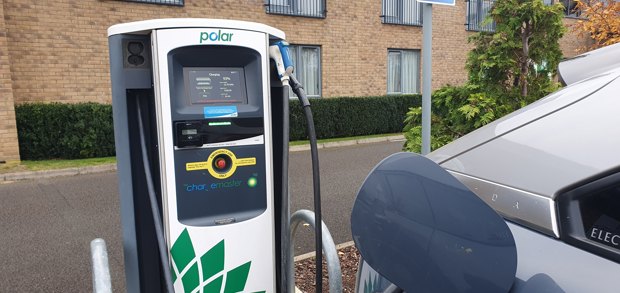
Date: 25 October 2021
It’s no secret that one of the biggest fears that buyers have when they’re considering an electric car is will they be able charge it quickly when they’re out and about. It goes hand-in-hand with range anxiety and remains one of the biggest blockers to EV take-up. People want to know that when they’re out and about, they’re going to be able to find somewhere to charge - and charge quickly.
This is especially true of the Mazda MX-30 that I’m running. It’s designed for city driving and lower mileages, so when out on longer trips, that 125-mile range - and the next charging station - is never far from my mind. That means that I’ve been getting a first-hand taste of the ever-changing charging point landscape, new sites popping up, upgrades and gaps in the network being plugged.
This year has been a big one for the charging point networks, as the system matures and there’s more mainstream take-up. It needs to, too, as take-up of EVs (plus, of course, plug-in hybrids) is starting to soar too. In May, the number of EVs in the UK officially passed a quarter of a million (260,000) and if you add plug-in hybrids (PHEVs) into the mix, the number rises to more than 530,000. September saw the highest ever sales of plug-in vehicles in a month, with more than 46,600 new plug-in registrations, which means that the that month meant that the number of plug-ins on UK roads has increased by more than 75% since September 2020.

That’s a lot of additional pressure on the charging network - and underlines the need to dramatically increase the number of charging points.
Supermarkets is one area where I’ve noticed significant developments when it comes to installing new chargers. Often with big car parks, easy access, and infrastructure near by, it makes sense for these car parks to become charging hubs and are useful for when you’re doing the weekly shop. If you use a Tesco, you may have noticed Podpoint charging points cropping up - the firm did a deal with the supermarket a few years back to add 7KW, 22KW and 50KW chargers to their car parks. With decent national coverage, I’m finding this network of charging stations (especially the fast-charging 50KW valiant) especially useful on longer trips, as they’re easy to spot, usually unoccupied and you can combine with a shop to reduce wasted time. The slow chargers are free, too.
But we’ve also seen other retail outlets get in on the action as well this year. Lidl (again with Pod Point) installed its 100th charger - though it has far from full coverage and in total more than 1,000 new EV chargers have been installed at supermarkets in the past couple of years.
Outside of retail, dedicated hubs are being opened by Instavolt with rapid (50kw+) and ultrarapid (100KW+) charging points - the later being fast enough for 80 miles in 15 minutes. These are much like big service stations, designed for charging a lot of cars quickly. One eight-bay is on the M6, near Chorley, while the Banbury site has been expended too. Similar projects are underway from other providers, such as Osprey, MFG and Moto too.
But the number of new charging points and stations doesn’t necessarily mean a care-free charging experience. Too many require an app to be downloaded or for you to join a club or scheme. After the first couple of these, I decided that it was an unnecessary bother and now specifically seek out charger that use a contactless payment, rather than payment/access via an app. After all, you don’t need to be a member to use a BP fuel pump, why should you have to download an app to use a charging station? Instavolt ticks the box much of the time for me, with fast chargers that not only take ‘normal’ contactless payment, but are fuss-free.
And while the number of charging points is improving, it only tells part of the story. Too many of these - especially the faster chargers - are concentrated in places like London and the surrounding areas. With higher demand and a larger population, that’s understandable, but there are significant swathes of the country, particularly in rural areas, where it’s difficult or impossible to to access a fast/er charger and that needs to change if EVs are truly going to have universal appeal.
Out and about charging - what has been my experience?
What is the reality of the charging network in the UK at the moment?
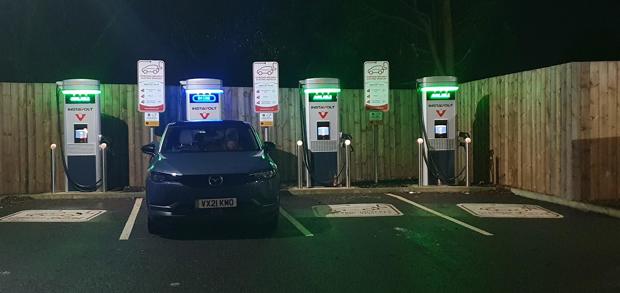
Date: 11 November 2021
In my previous update, I gave an insight into how charging networks are expanding and evolving and the challenges they continue to face. It’s all very well having plans, strategies and attracting large amounts of investment, but if the actual experience of EV owners and drivers differs from the marketing hype, it’s going to do very little for take up.
As I’ve said before, it’s important to have a number of go-to chargers up your sleeve (plus a few back-ups) if you’re driving an MX-30. Aside from the rear visibility, it’s great around town, quick off-the mark, easy to park (especially so with 360 degree parking cameras) and able to easily dart in-and-out of traffic. Perfect if, like most people, you’re only covering 40-50 miles per day. But longer trips means planning ahead and having contingencies just in case the charging station is full, broken or you unexpectedly have less range than expected.
And on that, the MX-30 has been pretty good. While its range is at the lower end of modern EVs, it has - so far - been pretty accurate and there hasn’t been much in the way of ‘range inflation’. While some owners of other EVs report that the dashboard range that they are shown bears little resemblance to what they’re seeing in real life driving conditions, the MX-30 lives up to what it claims. If it’s saying 125 miles of range on the trip, I’ve generally been getting 125 miles out of it. It does make me wonder about whether this Mazda really is off the pace when it comes to range or whether the firm has opted for a more honest and transparent approach when it comes to quoting range and is in face much closer to rivals in reality.
The bit that car manufacturers have very little sway over, of course, is actually one of the most important parts of owning and running an electric car and that’s the charging experience. It’s vital that the network is comprehensive, fast and not overcrowded for take-up of electric cars to continue at the current pace.
My previous update tackled - at least in part - the comprehensiveness of the network. It’s an ever-changing picture, but one that is improving. Yes there’s still a long way to go, but my experience has been that it’s getting easier to find a charging point (and a fast one at that), but there’s still a nervousness around how far you may have to travel - especially out in the sticks.
Reliability has been good for me too. I’m yet to turn up to a charger that is broken or out of service. Checking ahead helps and there are apps around that use real-time information to tell you whether a charging point is in-use or out-of-service to save you a wasted trip. A quick glance at the map shows a large number of charging stations with issues (even though I’ve managed to avoid them) and this needs to change as more EVs hit the road.
The real issue for me has been the fast chargers and the speed at which they charge the car, as this can make a real difference to a journey - and not in a good way. I tend to look for 50KW charging points as these can in theory charge the Mazda MX-30 in around 40 minutes. That’s acceptable and can be factored-in to a longer journey. However, I’ve been finding that all too often that a 50KW charger is only dispensing electricity at half - or less - of that rate. This can have a significant impact on trips, if you’ve planned to be charged-up and on your way in around 45 minutes. At 25KW, a charge is taking 1h 20m, which can have a disastrous impact if you haven’t planned for a stop of that length on your trip and you’re in a hurry.

So why does this happen? As for the non-technical minded car buyer this makes no sense. Firstly, there’s the state of charge. Batteries are quicker to charge between 20% and 80%, so if you’re outside of these parameters, ther charge will slow down to prevent damage to the battery pack. Secondly, battery temperature plays a key part - if it’s cold, it’s going to charge more slowly. Then there’s restricted power from other rapid chargers sharing the same connection at a charging point.

While a lot of people talk about the (admittedly now growing) charging infrastructure, range and costs as the key things that people are nervous about when buying a car, varying charging speeds feels to me as if it’s one of the hidden drawbacks that may only become apparent when you’re living with your EV day-to-day.
No complaints from readers about the Mazda MX-30 - but what about other electric cars?
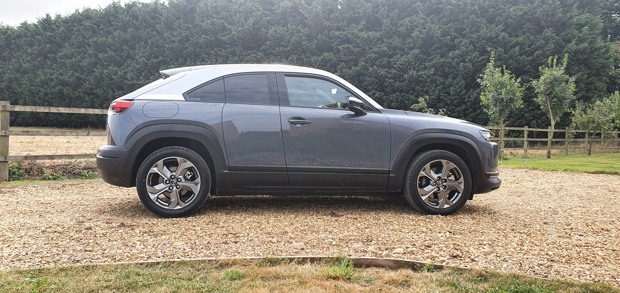
Date: 16 February 2022
With more electric cars hitting the road than ever, it stands to reason that the number of complaints will rise as well - after all, electric cars are cars like any other, things go wrong from time-to-time and there are times when buyers won’t be entirely satisfied.
The Motor Ombudsman, the body that handles complaints in the automotive industry, has released some findings from complaints submitted by owners in the past 12 months, which gives an insight into the sort of issues that other electric car buyers are facing. It said that a third of disputes submitted by consumers in relation to the purchase or ownership of an electric vehicle (EV), to its dispute resolution service in 2021, were due to an issue at the point of sale, or because of the customer service they had subsequently received after buying the car from a business. In other words, the same issues that rear their heads when buying a petrol or diesel car can still be there for EV buyers.
EV buyers who brought their complaints to The Motor Ombudsman over the course of last year, were driven by factors such as vehicle delivery delays, being overcharged versus pre-agreed prices, having vehicle registration issues on collection, and their concerns not being resolved by the retailer to their satisfaction.
The other two thirds of complaints were for EV-specific issues. Software glitches drove the second biggest cause of complaints in relation to an electric vehicle at 13 per cent, with updates and system errors sparking customer discontent. Similarly, 12% of the difficulties highlighted by consumers in 2021 resulted from the car not charging to its full potential, with component-specific problems relating to the charging flap and socket also mentioned.
Elsewhere, bodywork and interior quality issues were nearly 20 per cent of complaints.
Despite much noise about batteries and range around electric cars, this accounted for just 6 and 7 per cent of complaints respectively. Battery malfunctions reported included a single case of a vehicle fire, with parts delays, and lower specification battery replacements, amongst the incidences logged by EV buyers. The principal concern with the range was the delivery of lower-than-advertised mileage on a full charge, a particular issue for EV owners residing in rural areas who rely on being able to drive a significant distance after plugging in.
There were far fewer complaints about the mechanics of an EV than with conventionally-fuelled cars. The reasons for this being there’s fewer EVs on the road and there’s far fewer moving parts under bonnet - so less to go wrong.This is in contrast to around 1,700 service and repair cases which were passed to The Motor Ombudsman’s dispute resolution team last year, due to a problem in conjunction with a petrol, diesel or hybrid vehicle.
On the subject of facts and figures for the past 12 months, The Society of Motor Manufacturers and Traders (SMMT) is the trade body for the motor industry. It has just released data for last year’s new car registrations showing 2021’s most popular colours. What really stuck out for me is that whether you have an EV, hybrid, petrol or diesel, grey remains the most popular colour option. Almost a quarter of all cars hitting the roads last year were grey (and no, I’m not going to make a shades of grey quip) After that 20 per cent of cars we black and 17 per cent white, showing that Brits currently prefer a monochrome colour palette.
Mazda has done something a bit different with paint on the MX-30 - outside of the seemingly popular grey, there there’s some really eye-catching colours and treatments. You can get an SE-L Lux with single tone Arctic White solid, or Polymetal Grey Metallic, Ceramic Metallic and Jet Black Mica, plus Machine Grey Metallic or opt for Sport Lux to get the option to choose the optional three-tone design on Soul Red Crystal or Ceramic Metallic main body colours. In addition, Polymetal Grey Metallic can be matched to a Brilliant Black roof and Silver Metallic side panels.
